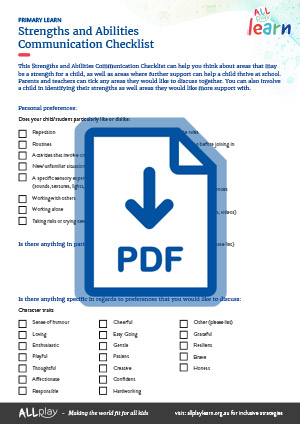
Blind and Low Vision
On this page:

About blind and low vision
‘Blind and low vision’ refers to significant and ongoing challenges with the ability to see. Some children may be considered ‘legally blind’ if they cannot see beyond six metres (compared to 60 metres for a child with normal vision) or if their visual field is less than 20 degrees in diameter (compared to 140 degrees for a child with normal vision). Some children may be considered to have ‘low vision’ if they have permanent vision loss that cannot be corrected with glasses and their ability to complete everyday tasks is affected. Children with low vision may have some sight, but experience difficulties with visual acuity (being able to see detail), accommodation (being able to focus), field of vision (the area that can be seen), colour vision and adapting to different lighting between environments.
As a teacher you can best support the student by knowing about the type and severity of vision impairment they have. Some children might be learning to read Braille, or use low vision aid technology like electronic magnifiers, closed-circuit television or iPads™. They might need large print materials. Understanding each child’s strengths and abilities will allow you to develop ideas about ways to make education safe, fun, and as inclusive as possible.

Strengths
What might be some strengths?
- Students who are blind or low vision may have the same capacity for learning as other children.
- They may have normal reading comprehension (i.e. they can understand what words and sentences mean).
- They might be skilled at identifying things through touch.
- Some might be able to learn number concepts through hearing.
- They can be resilient and adaptable.
Where might you provide support?
- Some students might have challenges with reading. This could include getting tired easily after reading for long periods, taking longer to read, or making more reading errors.
- Some children may have trouble making eye contact, reading facial expressions and observing social cues.
- They may have much less access to educational material than their peers.
- They might at times feel frustrated or disappointed with their vision or with looking different. They might feel self-conscious about using low vision aids which can be a barrier to making friends (e.g. magnifiers, CCTV, iPads™). They may feel like they don’t fit in, or have low confidence or low self-esteem.
- Some students might have delays with movement, balance and object control. This may make physical education and being independent challenging for them.
- Some students may have difficulties with starting tasks, problem solving, planning, organisation and memory.
- Walking around in unfamiliar places can be difficult.
- They may not have as many opportunities to develop play skills and might not begin play activities without prompting.

Evidence-based strategies
Identify different ways that a child can learn
Consider the environmental setup
Practice literacy skills

Best practice tips
Be proactive
Tailor teaching to students’ needs
Consider the learning environment
Encourage clear communication
Help students develop their social skills
Maximise technology
Collaborate with families
Promote self-determination
- Use computer-assisted instruction and interactive e-learning. This involves using regular and specialised devices (for example, laptops, tablets, braille notetakers) to deliver and enable access to academic content and instruction. Supported e-text can be modified by students to enhance their comprehension and learning. Giving students immediate access to content and instruction which they can interact with and manipulate can enable independence and collaboration with peers. When using these devices, ensure that the student has the technology skills required to participate, and closely monitor student progress.
- Maintain regular communication with families. Families can provide valuable information about their child. This information can be incorporated into the classroom to better address student preferences and needs, enabling their learning and inclusion.
- Promote self-determination. Empower and teach children to make simple choices, set goals, be independent, and develop problem-solving abilities. Use technology as needed.

Curriculum considerations

Other considerations
Statewide Vision Resource Centre
Behaviour
Safety
First aid
Safety drills
Friendships
Homework
Excursions
Transitions
Braille
Low vision aids
Other co-occurring conditions

Relevant resources
Visit our resources page for a range of resources that can help to create inclusive education environments for children with disabilities and developmental challenges. Some particularly relevant resources for children with who are blind and low vision include our Audio Stories, and:



